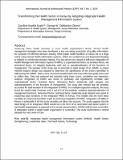| dc.contributor.author | Kyalo, Caroline Kawila | |
| dc.contributor.author | Odhiambo-Otieno, George.W. | |
| dc.date.accessioned | 2019-05-15T13:51:41Z | |
| dc.date.available | 2019-05-15T13:51:41Z | |
| dc.date.issued | 2019-05 | |
| dc.identifier.citation | Kyalo, C., & Odhiambo-Otieno, G. (2019). Transforming the Health Sector in Kenya by Adopting Integrated Health Management Information System. International Journal of Professional Practice, 7(1), 11-23. Retrieved from http://library.kemu.ac.ke/ijpp/index.php/ijpp/article/view/24 | en_US |
| dc.identifier.uri | http://library.kemu.ac.ke/ijpp/index.php/ijpp/article/view/24 | |
| dc.identifier.uri | http://repository.kemu.ac.ke:8080/xmlui/handle/123456789/328 | |
| dc.description | http://library.kemu.ac.ke/ijpp/index.php/ijpp/article/view/24 | en_US |
| dc.description.abstract | Achieving better health outcomes is every health organization’s dream.Several health management strategies have been developed;a key one being production of quality information for purposes of informed decision making.Most public health facilities in Kenya are by large extent using manual health information systems,which are cumbersome and fragmented leading to delayed or uninformed decision making. Five key drivers are viewed to influence Integration of Health Management Information System(IHMIS): i) organizational factor, ii) technical factor, iii) behavioral factor, iv) adopted leadership style and v) operationalization of the functions of management.The purpose of the study was to prescribe an ideal design of an IHMIS.A mixed method research design was adopted to determine the significance of the drivers identified in influencing the IHMIS.Both semi-structured questionnaire and a key informant guide were used to collect data that was analyzed and reported using mean scores,correlation and regression analysis.Integration of HMIS was found to positively and significantly correlate with organizational factor,technical factor,behavioral factor,leadership style adopted and operationalization of the functions of management.The study also showed that all variables accounted for total variation in the integration of HMIS.In a multiple regression analysis,the study found the model valid.However only 4 out of 5 of the predictor variables(operationalization of management functions,behavioral factor,technical factor,leadership style adopted) were good in explaining total variations in the integrated HMIS in Kenya. This implies that the more these variables are improved the better it gets in achieving integration of HMIS which is achievable if all the study variables are taken into account.The study suggests that the ideal design of an integrated HMIS would be in the form of an automated web based system in each health organization as opposed to the current manual system.IHMIS will be more successful,if integration within a single health organization is successful.The study recommends a central database for each level of care. | en_US |
| dc.language.iso | en | en_US |
| dc.publisher | International Journal of professional practice (IJPP) | en_US |
| dc.relation.ispartofseries | International Journal of professional Practice (IJPP) Vol .7 No. 1, 2019; | |
| dc.subject | Integrated health management information system | en_US |
| dc.subject | Health System | en_US |
| dc.title | Transforming the Health Sector in Kenya by Adopting Integrated Health Management Information System | en_US |
| dc.type | Article | en_US |

